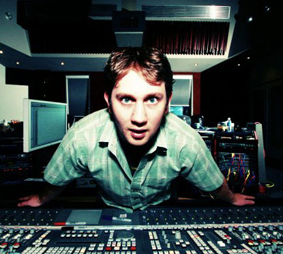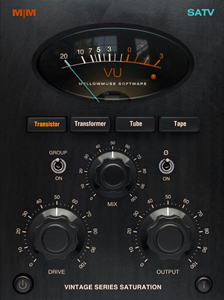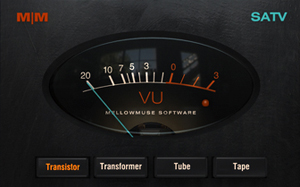Mellowmuse SATV Vintage Saturator Reviewed By Zach McNees
It pains me to say it, but the days of mixing entirely in the analog domain and using your DAW as merely a tape machine are waning.
As proof of this, the number of high quality tape emulation and saturation plug-ins on the market has grown considerably in the past year. Leading the revolution to warm up your ones and zeroes is the SATV Vintage Saturator by Mellowmuse.
TECH SPECS: The SATV is a native-only plug-in for use on Mac and PC and retails for an incredibly affordable $99. It comes in VST, AU and RTAS flavors depending on what your DAW of choice uses. It boasts 4x Oversampling for low aliasing. This is great though I would LOVE to see an option for 8x as my rig could more than handle it. I’m a big fan of plug-ins that are able to offer a super high resolution option for those of us with the CPU power to handle it.
WHAT IT DOES: The SATV is primarily used to emulate the sound of four different pieces of hardware: Transistors, Transformers, Tubes and Tape. Although you can certainly push any of these to drastically alter the sound, the goal with the SATV is, primarily, to add warmth, character and help glue your mix together.
THE INTERFACE: Mellowmuse’s graphic designers did an excellent job on the visual aesthetic of the plug-in. On the face we have a digital representation of a VU meter, 4 selectors for the different saturation algorithms, switches for group on and off (which I will explain in detail further), a phase reversal switch and three knobs for “MIX”, “DRIVE” and “OUTPUT.” There is also a working “power” button that actively engages and disengages the plug-in just as the bypass button would at the top.
The four algorithms to choose from are clearly labeled “Transistor,” “Transformer,” “Tube,” “Tape.” The three main knobs are self-explanatory and work exactly how you would expect. “Drive” will increase the amount of saturation/distortion in the signal path, “Mix” blends the amount of driven signal with the amount of clean (original) signal and “Output” simply gives you control over the final blended signal going back into your mix. Finally, there is the group switch, which is one of the most unique (and most useful, in my opinion!) features of the SATV plug-in. Simply put, the settings of all SATV plug-ins in your session that are set to group mode will be sync’d and can be controlled by any single instance of the plug-in.
IN USE: All of my SATV tests were within the Pro Tools platform running version 8. In most cases for me, the key to using SATV is subtlety. This is definitely a plug-in where the theory of “less is more” applies, especially if you end up using many instances of it across individual tracks.
The first thing that I discovered is that SATV doesn’t work well as a final mix bus saturation plug-in. Rather, it should be used a tool to shape and “glue” individual tracks or sets of tracks together.
More often than not, the SATV was a helpful addition to almost any type of sound I could throw at it. I primarily used SATV on two different mix projects. One is a children’s album with several different singers and genres of music including Rock, Americana and Country. The other project was a more straight-forward NYC rock band called B-Theory with well recorded, driving rock drums and guitars. SATV proved very helpful on drums, electric bass, electric guitars, piano, male lead vocals and more.
When used judiciously, I found that the subtle blending of extra bite and saturation helped give many of these sounds an added life that is hard to find in strictly digital audio.
There were instances however where I simply found that adding saturation or warmth to a given track just didn’t suit the sound I was looking for. For example, I found that when mixing the female lead singer from B-Theory, the SATV seemed to detract from the airy crystal-like quality that I loved about her voice. After a few minutes of experimenting I decided to leave that particular vocal alone.
SATV’s four main algorithms are uniquely different and can all be very useful. Getting the proper sound for a given track can take several minutes of critical listening and A/Bing both between the different algorithms themselves and bypassing the plug-in itself to see exactly how the sound has changed overall.
The “Transistor” setting sounds fantastic on drums and bass adding just the right amount of subtle grit and life while not sounding overly saturated. “Transformer” also has a lively and dirty feel to it and can really sound great when cranked up if you’re looking to drive a track particularly hard as an effect.
The “Tube” setting can be killer on guitars and vocals and really achieves an accurate replication of 3rd level harmonic distortion when needed to take the edge off of the sound. I found myself using “Tape” the least out of the four settings but it certainly can still be useful in helping soften a track. “Tape” seemed best suited for guitars and chord-based instruments that tend to be rich in high frequencies such as electric guitars. In general, I found anything sent through “Tape” with the drive knob past 25 added too much hiss, digital sounding noise and overall unpleasant tones to my track.
Group mode is where things get really interesting. I opened up a song from and the B-Theory album and proceeded to make a plug-in space for SATV across all my drum tracks in between my EQ and my compressor.
Some people like to make saturation plug-ins their first piece in the chain, where I prefer to shape my sound a little bit and lose any unwanted frequencies and then bring SATV into the mix. Not only does SATV sound remarkable when used individually across an entire drum kit, I also found that I also saved a lot of time by being able to experiment with different tones and sounds and watching the knobs and settings change across all the tracks together.
The tracks as a group seemed punchier and more driven in a way that really helped make the rest of the mix sparkle. It was very easy to see just how helpful group mode could be for situations like this.
The best way to view group mode in action is to open up several SATV plug-ins, put them in group mode and watch them all magically change settings together when controlled by any given plug-in. The first setting “Transistor” was like glue across my drums. The kit overall sounded livelier, and more glued together than it ever had. I actually spent a few seconds considering whether I still had time to re-print the whole album with my SATV settings across my drums!
The included bypass switch which is designed to look like a power button also works in group mode and is extremely helpful for bypassing all instances of SATV in group together to A/B the sound of everything against its original sound. This group mode functionality makes the SATV the most useful of any of the saturation plug-ins I’ve tried.
TO BE CRITICAL: I do have a few small issues with SATV that I would love to see addressed in future updates. First of all, if you first get a great sound that works well with the plug-in and then you decide to switch into group mode, your settings will be lost forever with no way to undo.
I discovered this the hard way very quickly and have made the same mistake a couple more times since. Perhaps an “Undo” button would be helpful or at least a fair warning the first time that selecting group will change your settings.
Second is the design of the phase switch. This switch defaults to pointing to the ø symbol and can be switched to the “on” position. This confused me — I find myself taking an extra second every time I come back to visit an SATV plug-in in my session to wonder if it is in fact phase flipped. Of course, I realize that engaging it to the “on” side will flip the phase of the signal but I think a clearly labeled “ø in” and “ø out” switch or a single “Phase” push button would do the trick without leaving any room for user doubt.
Also on my wish list for future updates is that there be several instances of group mode available via an A/B/C/D selector switch or comparable. I found that while group mode was extremely helpful across my drums, these same settings did not translate as well into other tracks in my session like bass, guitars, and vocals. It would be amazing to be able to utilize this same feature 3 or 4 times within a given mix.
IN CONCLUSION: Overall, SATV is a welcomed addition to my plug-in list and has very quickly become a staple of almost every mix I’ve worked on since having it. Considering the price, I’d have to say SATV ranks #1 on my list of the most valuable plug-ins for sound and features vs. price. Well done, Mellowmuse!
Zach McNees is a Brooklyn-based producer/engineer/mixer and live recordist who’s worked with Bjork, Rob Thomas, The Gregory Brothers, Pixies, Liars and Alice Cooper. Get in touch with Zach via http://www.zachmcnees.com.
Please note: When you buy products through links on this page, we may earn an affiliate commission.










sonic producer
January 12, 2012 at 12:37 pm (13 years ago)love sonic producer
Heavy Empty
June 22, 2014 at 7:16 am (11 years ago)cool mate- just downloaded the demo, thanks for the quality review, looking forward to seeing what this thing can do